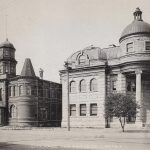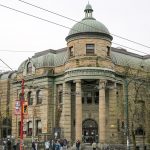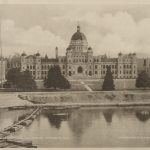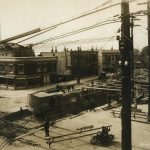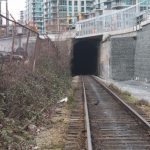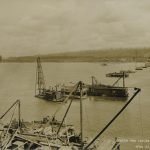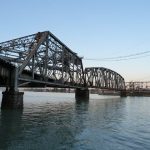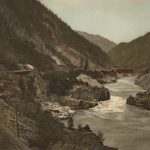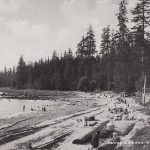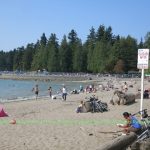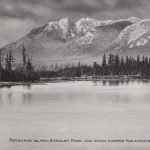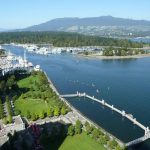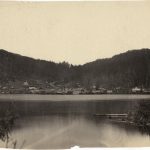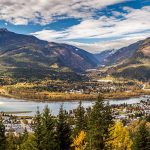Many thanks to guest blogger Ashlynn Prasad for contributing the below post! Ashlynn is a graduate student at UBC’s School School of Library, Archival and Information Studies and the curator of our new exhibition of photographs from the Uno Langmann Family Collection of B.C. Photographs.
When I first began perusing the Uno Langmann Family Collection of B.C. Photographs, which is available for public viewing in Rare Books and Special Collections in the Irving K. Barber Learning Center, and digital copies of which can be found online, I approached the photographs with the awareness that many of them were between 100 and 150 years old, and I therefore began the project with the expectation of finding photographic evidence of how much British Columbian scenery and landmarks have changed in the past century, after rapid advancements in technology as well as continuing urban development.
While I did find evidence of change, I was surprised to also find that many of the landmarks closely associated with British Columbia have varied very little in appearance in the past century. I got the sense while looking through the photographs that certain images, though they were taken up to 150 years ago in some cases, could have been taken a mere few days ago. With this in mind, I designed the exhibition in the spirit of a before-and-after, except that instead of juxtaposing new images with old images, I juxtaposed turn-of-the-century images with each other, showing on the one hand images which seem dated (from a modern observer’s perspective) and on the other hand images that look quite familiar. For a more traditional before-and-after comparison, please see below for contemporary versions of the scenes depicted in the exhibition.
Something else that I tried to keep in mind during the curation of this exhibition was the audience to which the photographs would likely be exposed while on display in Ike’s Café. On a personal note, I was born in the lower mainland and spent the earlier half of my life here, before moving to the United States and spending the latter half there. Because of this, I found myself tangentially familiar with a lot of the names I encountered during the curation of the exhibition, and in some instances the scenes in the images themselves were also intimately familiar to me. However, having been away for so long, I also had to do quite a bit of Google Maps searching of place names that would likely be extremely familiar to someone who had spent their entire life here.
I tried to keep in mind that the individuals coming through the café will have varying levels of familiarity with British Columbian landmarks – some will know them well, some will be experiencing them for the first time, and many will fall somewhere in between. I tried to curate an exhibition that could appeal to people at any position on the spectrum by showcasing landmarks that are generally quite well known, and which a large majority of people – even if they’re completely new to the area – will at least have heard of, such as Stanley Park or Fraser River. This way, the exhibition is ostensibly capable of drawing an emotional response from almost anyone, whether that’s the curiosity and nostalgia of seeing a turn-of-the-century version of a place one knows very well, or whether that’s a piqued interest in a place one has never seen before. For at least some of the photographs, I hope we can all enjoy the intrigue of noticing how much has changed in the last 100 years, and perhaps even more so, how much has not.
– Ashlynn Prasad, Exhibition Curator and MAS/MLIS Candidate at the University of British Columbia
- Carnegie Library (circa 1900). University of British Columbia Library, Rare Books and Special Collections, Uno Langmann Family Collection of B.C. Photographs, UL_1466_0003. Photographer unknown.
- Carnegie Library (present-day). Source: https://www.vpl.ca/location/carnegie-branch
- Victoria Parliament Buildings (circa 1900). University of British Columbia Library, Rare Books and Special Collections, Uno Langmann Family Collection of B.C. Photographs, UL_1451_0009. Photograph taken by H. S. Henderson.
- Victoria Parliament Buildings (present-day). Source: http://www.victoriabc.ca/bc-parliament-buildings/
- Lonsdale Tunnel (1928). University of British Columbia Library, Rare Books and Special Collections, Uno Langmann Family Collection of B.C. Photographs, UL_1612_01_0046. Photograph taken by Canadian Photo Co.
- Lonsdale Tunnel (2015). Source: http://www.lowerlonsdale.ca/throwback-thursday-lonsdale-rail-tunnel/
- New Westminster Bridge (1903). University of British Columbia Library, Rare Books and Special Collections, Uno Langmann Family Collection of B.C. Photographs, UL_1016_0029. Photographer unknown.
- New Westminster Bridge (2014). Source: http://historicbridges.org/bridges/browser/?bridgebrowser=britishcolumbia/newwestminsterrailwaybridge/
- Hells Gate (circa 1920s). University of British Columbia Library, Rare Books and Special Collections, Uno Langmann Family Collection of B.C. Photographs, UL_1116_02_0022. Photograph taken by Byron Harmon.
- Hells Gate (present-day). Source: http://knowbc.com/ebc/Books/Encyclopedia-of-BC/H/Hells-Gate
- Second Beach, Stanley Park (circa 1900). University of British Columbia Library, Rare Books and Special Collections, Uno Langmann Family Collection of B.C. Photographs, UL_1466_0017. Photographer unknown.
- Second Beach, Stanley Park (present-day). Source: http://stanleyparkvan.com/stanley-park-van-beach-second-beach.html
- Stanley Park, Deadman’s Island (circa 1900). University of British Columbia Library, Rare Books and Special Collections, Uno Langmann Family Collection of B.C. Photographs, UL_1466_0012. Photographer unknown.
- Stanley Park, Deadman’s Island (present-day). Source: https://rentitfurnished.com/blog/two-harbour-green-unbeatable-vancouver-luxury-waterfront-living/
- Lillooet River settlement, circa 1860s. University of British Columbia Library, Rare Books and Special Collections, Uno Langmann Family Collection of B.C. Photographs, UL_1019_0033. Photograph taken by Charles Gentile.
- Lillooet River settlement (present-day). Source: https://www.britannica.com/place/British-Columbia/Climate
